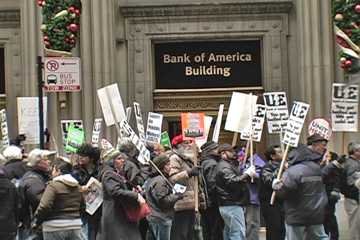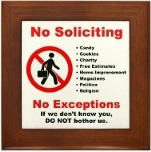|
|
|
 |
|
The Rise and Fall of Bank of America
| |
|
In recent years Bank of America (BOA) has strayed very far from the high
standards set by its founder, AP Giannini. During the 1990s BOA quickly expanded by
buying up several other banking corporations with hundreds of branches across
the country. BOA soon become the largest U.S. bank holding company,
with combined assets of $570 billion, and 4,800 branches. BOA also began acquiring assets in the financial services
industry; FleetBoston Financial, credit card giant MBNA, The United States Trust Company from the Charles Schwab Corporation,
Countrywide Financial, and Merrill Lynch. Both Countrywide Financial and
Merrill Lynch were teetering on the brink of insolvency because of bad
investments and numerous lawsuits, but BOA apparently thought they were getting a
bargain. |
 Protest at Bank of America in Chicago on Dec. 10, 2008 |
|
BOA's acquisition binge finally backfired during the global financial meltdown of 2008. As the number one underwriter of global high-yield debt, Bank of America was in immediate danger of imploding. Since it was considered "To Big To Fail" BOA was bailed out by the Troubled Asset Relief Program (TARP) twice: they received $25 billion in 2008 and another $20 billion in 2009. BOA used the money to shore up its balance sheet and pay bonuses to its chief executives, while sharply reducing new small business loans and mortgages, which deepened and extended the financial crisis it had helped launch. Once Congress began asking tough questions about what happened to the TARP money, BOA decided to give the money back so it would be free to continue doing as it pleased. In the past 3 years Bank of America has been accused of multiple counts of fraud, as well as many other financial improprieties and paid several fines totaling hundreds of millions of dollars. BOA has been accused of many abuses related to foreclosing on some of the millions of mortgages they hold, such as telling people to stop payments on their mortgages so they can qualify for a government-backed loan modification program and then foreclosing for non-payment, robo-signing thousands of legal documents, frequent bank "errors" that cause foreclosure on people who aren't actually in arrears, and at least three cases where they foreclosed on homes that weren't even mortgaged. As public anger mounted over reports of abuses by Bank of America, they compounded their public relations problems by announcing a new $5 monthly fee on debit cards. AP Giannini, Banker for the Little Guy, would probably turn over in his grave if he knew that his company was trying to recoup losses from its own mistakes by charging nuisance fees to those who are least able to afford them. The debit card fee announcement in 2011 was the final straw for many of their customers and they responded by taking their business elsewhere. BOA soon rescinded the fee and stepped-up their public relations efforts, but it was too late to stop the exodus. Bank of America is no longer the largest banking corporation in the US and a recent survey found that just over 25% of Bank of America's current customers were satisfied with the bank overall. Bank of America's satisfaction rating among its customers is now the lowest by far of any major bank.
|
|


